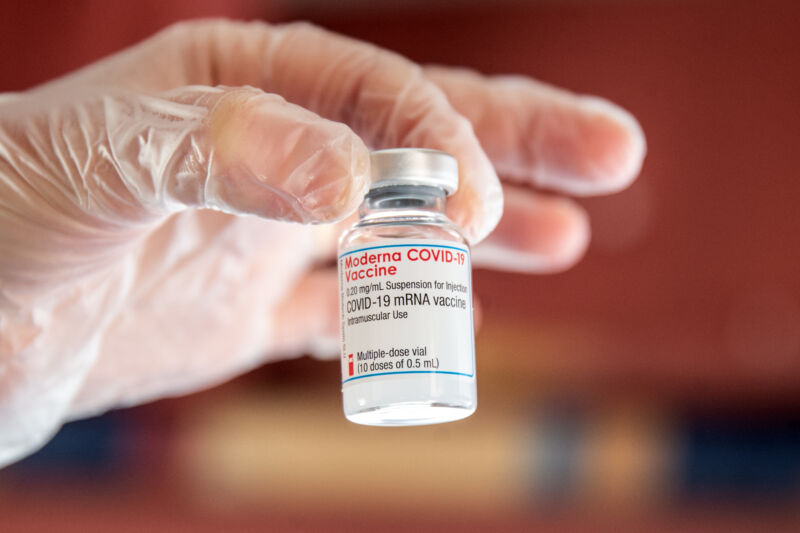Mixing and matching COVID-19 vaccines for booster doses appears safe and as effective—if not more effective—than sticking with the same vaccine for a booster dose. That's according to preliminary data posted online Wednesday from a clinical trial run by the National Institutes of Health.
The trial bolsters what some have long hoped: that mixing and matching vaccines could provide stronger, broader protection against the pandemic virus and all its variants.
The trial was not large enough to definitively indicate which combination of vaccines offers the best protection. And the early results, available on a preprint server, have not yet been peer-reviewed. But the preliminary trial findings do hint that Moderna's mRNA vaccine may offer the strongest protection all around—backing up similar findings from earlier vaccine-effectiveness studies. The data also suggests that people who received the one-shot Johnson & Johnson vaccine may want to get a boost with one of the two mRNA vaccines, either Moderna's or Pfizer/BioNTech's.
But most clearly, the study found that mix-and-match boosting increases protection and produces only similar side effects as boosting with the same vaccine. Or, in the authors words: "These data suggest that if a vaccine is approved or authorized as a booster, an immune response will be generated regardless of the primary Covid-19 vaccination regimen."
Nine combinations
For the study, researchers at various trial sites around the country recruited 458 people over the age of 18. Subjects were subsequently split into three groups of roughly 150 each. Those three groups had different initial vaccine regimens: either two doses of the Moderna vaccine, two doses of the Pfizer/BioNTech vaccine, or one shot of the Johnson & Johnson vaccine.
From there, each of the three groups of 150 were split into three groups of 50, with each of the smaller groups getting different boosters. So, for example, among the 151 people who received a Moderna vaccine initially, 51 went on to receive a Moderna booster, 51 got a Pfizer/BioNTech booster, and 49 got a Johnson & Johnson booster. The booster doses were given between 12 and 29 weeks after the initial vaccinations.
Next, researchers looked at the levels of binding and neutralizing antibodies the day of the booster shot (so before the boosters were able to kick in). The researchers checked those same levels 15 days later and 29 days later. Across all of the combinations, levels of binding antibodies rose between fourfold and 56-fold.
They also looked carefully at neutralizing antibodies—the antibodies that bind to and prevent SARS-CoV-2 virus from infecting cells. In people who had received the same type of vaccine for their initial doses and their booster dose, neutralizing-antibody levels rose fourfold to twentyfold. In people who got different vaccines, neutralizing-antibody levels rose sixfold to 76-fold.
The fold-changes strongly indicated that the booster doses increased protection across the board while mix-and-match perhaps have an edge. But the fold-changes can obscure some finer points. (You can see the whole table of results here, beginning on page 27)
Looking at just the average antibody levels in each group, subjects who initially got the Johnson & Johnson vaccine started with some of the lowest neutralizing-antibody levels on day 1. Their geometric mean titers of neutralizing antibodies ranged from 7.6 to 9 on day 1. As such, they had the smallest and the largest fold-changes after the boosts. Members of the Johnson & Johnson group who got a Johnson & Johnson booster saw their neutralizing-antibody levels rise only fourfold after 15 days (to 31)—the smallest change across all of the groups. But people who got the Johnson & Johnson vaccine followed by a Moderna booster saw a 76-fold rise (to 676)—the largest change.
Moderna’s edge
Overall, people who got the Moderna booster had the highest neutralizing-antibody levels regardless of what vaccine they got initially. Their geometric mean titers of neutralizing antibodies ranged from 676 to 900 at day 15. The group with the mean of 900—the highest level reported in study—had received the Moderna vaccine for their initial and booster doses. People who had initially gotten the Pfizer/BioNTech vaccine saw their geometric mean titers of neutralizing antibodies rise from about 25 to 786 after a Moderna booster.
People initially vaccinated with Moderna also had better starting levels of neutralizing antibodies compared to those seen in people initially vaccinated with the Pfizer/BioNTech vaccine. They had ranges of 58-89 and 19-25, respectively. People initially vaccinated and boosted with Pfizer/BioNTech vaccine saw their levels rise from 21 to 448. But that was still lower than the people initially vaccinated with Moderna and boosted with Pfizer/BioNtech—they saw levels rise from 58 to 678 after 25 days.
The researchers noted that previous studies have estimated that a geometric mean titer of neutralizing antibodies at 100 or above correlates with vaccine efficacy of 90.7 percent against symptomatic disease. All of the groups met that threshold, except for the group that got a both a Johnson & Johnson primary dose and booster dose.
In all, the study indicates that mixing and matching is a safe and effective way to bolster protection. Researchers will need to conduct larger studies to see if Moderna can maintain the lead it seems to have here, though. But the weak Johnson & Johnson results will provide plenty of fodder for debate when advisors for the Food and Drug Administration meet later this week to consider authorizing Johnson & Johnson booster doses.



3175x175(CURRENT).thumb.jpg.b05acc060982b36f5891ba728e6d953c.jpg)

Recommended Comments
Join the conversation
You can post now and register later. If you have an account, sign in now to post with your account.
Note: Your post will require moderator approval before it will be visible.